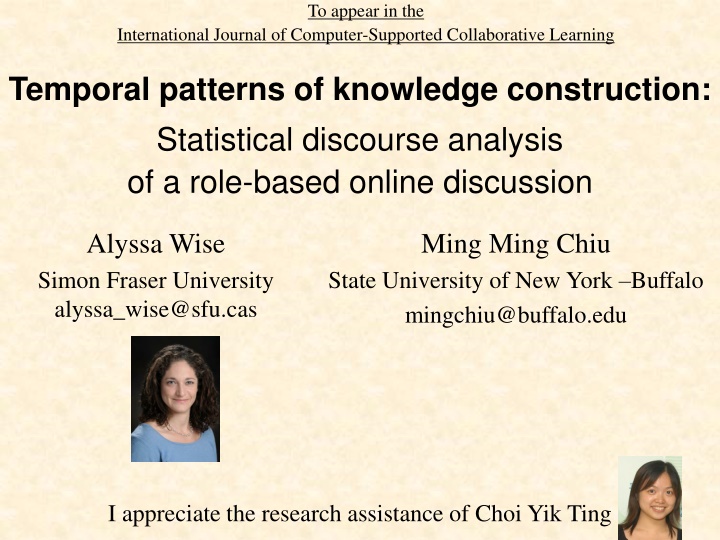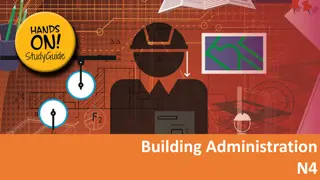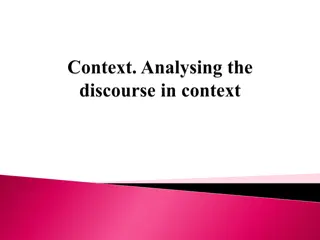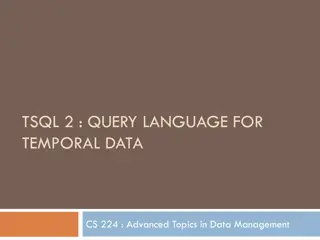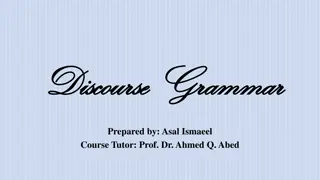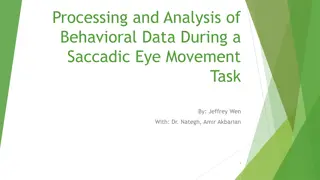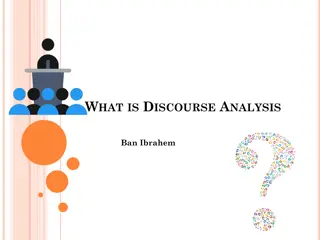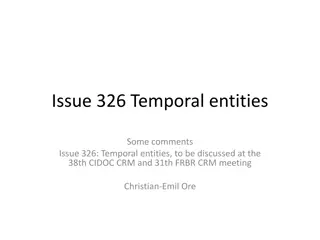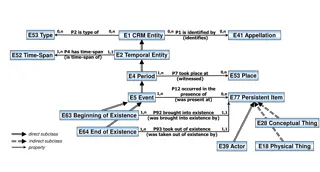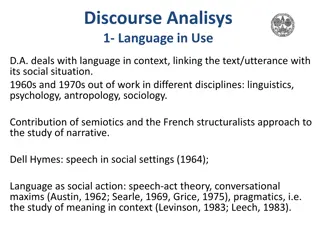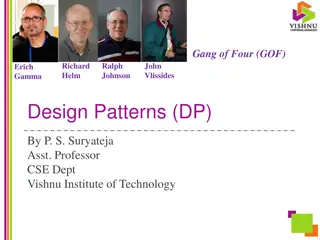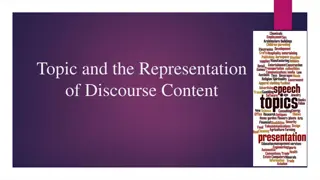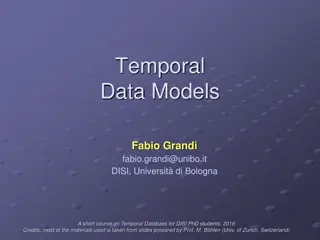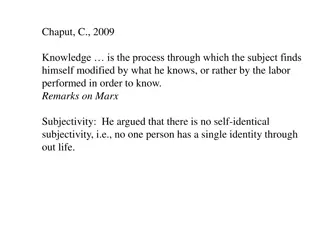Temporal Patterns of Knowledge Construction in Online Discourse
This study delves into the statistical discourse analysis of role-based online discussions, exploring patterns of knowledge construction and pivotal posts that shape distinct segments. The research context focuses on the dynamic flow of group interactions in collaborative learning settings, emphasizing the influence of individual contributions in group patterns over time. The Knowledge Construction (KC) Framework is applied to analyze how online forums facilitate idea sharing, exploring dissonance, negotiating meaning, testing modifications, and applying agreed-upon concepts. Through an examination of temporal dimensions and emerging themes in collaborative learning research, this study aims to uncover factors influencing the knowledge construction process in online discourse.
Download Presentation

Please find below an Image/Link to download the presentation.
The content on the website is provided AS IS for your information and personal use only. It may not be sold, licensed, or shared on other websites without obtaining consent from the author.If you encounter any issues during the download, it is possible that the publisher has removed the file from their server.
You are allowed to download the files provided on this website for personal or commercial use, subject to the condition that they are used lawfully. All files are the property of their respective owners.
The content on the website is provided AS IS for your information and personal use only. It may not be sold, licensed, or shared on other websites without obtaining consent from the author.
E N D
Presentation Transcript
To appear in the International Journal of Computer-Supported Collaborative Learning Temporal patterns of knowledge construction: Statistical discourse analysis of a role-based online discussion Alyssa Wise Simon Fraser University alyssa_wise@sfu.cas Ming Ming Chiu State University of New York Buffalo mingchiu@buffalo.edu I appreciate the research assistance of Choi Yik Ting
Motivation for the Study Online, asynchronous forums Can participate anywhere no geographic limits Can share ideas at any time more time to think But often disconnected, only lists of isolated ideas Guzdial & Turns, 2000; Herring, 1999; Thomas, 2002 Summaries Connect previous ideas and develop them But often occur at end of discussion & Do not benefit other members De Wever et al., 2007; Schellens et al. 2005; 2007 Encourage summaries in the middle of discussions?
Knowledge Construction (KC) Framework Gunawardena et al. s (1997) Five-Phase Model I think . I agree that Sharing Information 1 1 I don t think we agree on What we disagree about isn t Exploring Dissonance 2 2 If we can define expert then Can everyone be on board with Negotiating Meaning 3 3 Does research support our idea... What if we adjusted Testing / Modifying 4 4 Our discussion has shown We could also use it in context Agreeing / Applying 5 5
Research Context for the Study Emerging Themes in Collaborative Learning Research Understanding the details of how groups interact to construct meaning Focus on Process (e.g. Arvaja, 2007; Stahl, 2004; Strijbos et al., 2004) Studying the dynamic flow of interaction over time and how micro- and meso- time contexts influence student interactions Temporal Dimension (e.g. Chiu & Khoo, 2005; Kapur, 2001; Reimann, 2009) Examining how individuals in a group influence each other and in turn how this gives rise to group patterns Connecting Levels (e.g. Cress, 2008; Suthers & Teplovs, 2011)
Knowledge Construction Phase Possible KC Patterns 1a 2a 3 5 5 5 4 4 4 3 3 3 2 2 2 1 1 1 0 5 10 15 20 0 5 10 15 20 0 5 10 15 20 1b 2b 4 5 5 5 4 4 4 3 3 3 2 2 2 1 1 1 0 5 10 15 20 0 5 10 15 20 0 5 10 15 20 Post Number
Research Questions What patterns characterize knowledge construction processes during an online discussion? What characterizes pivotal posts that divide a discussion into distinct segments? Summaries? Which characteristics of a post influence the knowledge construction phase of the next post?
Roles Synthesizer (+) Pivotal Post Functions Summary (+) Time context Week Individual Control variables Gender Age Post Control variables # of words Time of post
Roles Synthesizer (+) Knowledge Construction Functions Summary (+) Time context Week Segment Individual Control variables Gender Age Post Control variables # of words Time of post
Methods Blended EdTech Course, 13 weeks f2f, 8 weeks of online discussions Learning Context Participants 2 groups of 10 students (UG / Grad & Teach) Task Weekly instructional design challenges 10 roles introduced, modeled & rotated weekly (each student had a role each week) Key role for this study = Synthesizer Asked to summarize the comments made midway through the week s discussion Roles
Function Give Direction New Idea Bring Source Use TheoryRespond Summarize Role Starter Inventor Importer Mini-me Questioner Elaborator Devil s Advocate Traffic Director Synthesizer Wrapper X X X X X X X X X X X X X
Content Analysis Unit of analysis: Post / Note / Message Objectively identified unit that its author defines Rourke, Anderson, Garrison, & Archer, 2001 Inter-rater reliability Krippendorf s (range: -1 1; desired: > .67) Inter-rater reliability ( ) .84 .65 .92 .73 .98 .76 .88 Variable Knowledge construction New Idea Bring in Source Use Theory Respond Give Direction Summarize
Statistical Discourse Analysis 4 types of Analytical Difficulties Time Outcomes Explanatory variables Dataset - No missing data
Statistical Discourse Analysis Strategies Difficulties regarding Time Breakpoint analysis + Model Multilevel analysis (MLn, HLM) Segments differ (S2 S4) Serial correlation (p8 p9) Test with I2 index of Q-statistics Model with lag outcomes, KC (-1) Branches of notes Store path: Identify prior turn 1 2 4 6 3 5 7 8
Previous Turn 1 2 3 Valid (-1) X X ID Ana Do three times four. Ben Three times four is seven Eva Three times four is nine. Jay Three times four is twelve. Action Turn # Valid? 1 2 3 4 X X Respond to post? 1 1 3 Valid (-1) X ID Ana Do three times four. Ben Three times four is seven Eva Three times four is nine. Jay Three times four is twelve. Action Turn # Valid? 1 2 3 4 X X
Statistical Discourse Analysis Strategies Difficulties regarding Time Breakpoint analysis + Model Multilevel analysis (MLn, HLM) Segments differ (S2 S4) Serial correlation (p8 p9) Multiple topics Test with I2 index of Q-statistics Model with lag outcomes, KC (-1) Branches of notes ( ) Store path: Identify prior turn Vector Auto-Regression Lag explanatory variables e.g., Valid (-1), Girl (-1) Valid (-2) 1 2 4 6 3 5 7 8
Statistical Discourse Analysis Outcome Difficulties Strategies Ordered outcome (KC 1-5) Infrequent outcomes (00010) Ordered Logit / Probit Logit bias estimator
Statistical Discourse Analysis Explanatory model Difficulties Strategies People, Groups & Topics differ Multilevel analysis Multilevel mediation tests Mediation effects (X M Y) 2-stage linear step-up procedure False positives (+ + + +)
Results KC Phases KC Phase 1) Sharing Information % of Posts 60 2) Exploring Dissonance 3 3) Negotiating Meaning 16 4) Testing / Modifying 4 5) Agreeing / Applying 17
Results: Summaries as Pivotal Posts Each discussion averaged 1 pivotal post (2 time periods)
Knowledge Construction Phase Results - KC Patterns 2a 3 1a Segments Skipped KC phases 5 5 5 4 4 4 3 3 3 2 2 2 1 1 1 0 5 10 15 20 0 5 10 15 20 0 5 10 15 20 No No 1b 2b 4 Pivotal Posts Distinct 5 5 5 4 4 4 Regressive Segments Regressive Segments 3 3 3 2 2 2 0 Segments 1 1 1 0 5 10 15 20 0 5 10 15 20 5 10 15 20 Post Number
Predicting Pivotal Posts Role Current Post Synthesizer Extensive Summary Pivotal Post Wrapper
Predict Knowledge Construction Time 2 posts ago Previous post Role After 1st pivotal post (-2) after 1st pivotal post Current post Knowledge Construction Respond New Idea (-1) after 1st pivotal post Synthesizer Summary Wrapper
Summary of Results KC pattern KC phase 1 KC phase 3 or 5 (Share) Few KC phases 2 or 4 (Dissonance, Testing) Pivotal post Extensive Summary often By Synthesizer or Wrapper usually Extensive Summary Showed higher KC Elevated KC of subsequent posts (Negotiate Meaning or Agree/Apply)
Implications Teacher / Designer - Increase midway summaries and elevate KC - Simple, effective intervention Assign Synthesizer Role Productive online discussions do not require all phases Researcher Empirically test Gunawardena et al s KC model New method for analyzing online discussion - Statistically identifies pivotal posts & segments - Test hypotheses about relationships among posts - Examine variables at multiple levels - Examine differences over Time
Further Questions With many choices of dimensions for the breakpoints, which one(s) should we use? What do identification of same vs. different breakpoints across different dimensions tell us? How can we do meta-analyses of multiple data sets with somewhat different codes? Which analyses (qualitative and/or quantitative) might be fruitful on the same data set?
